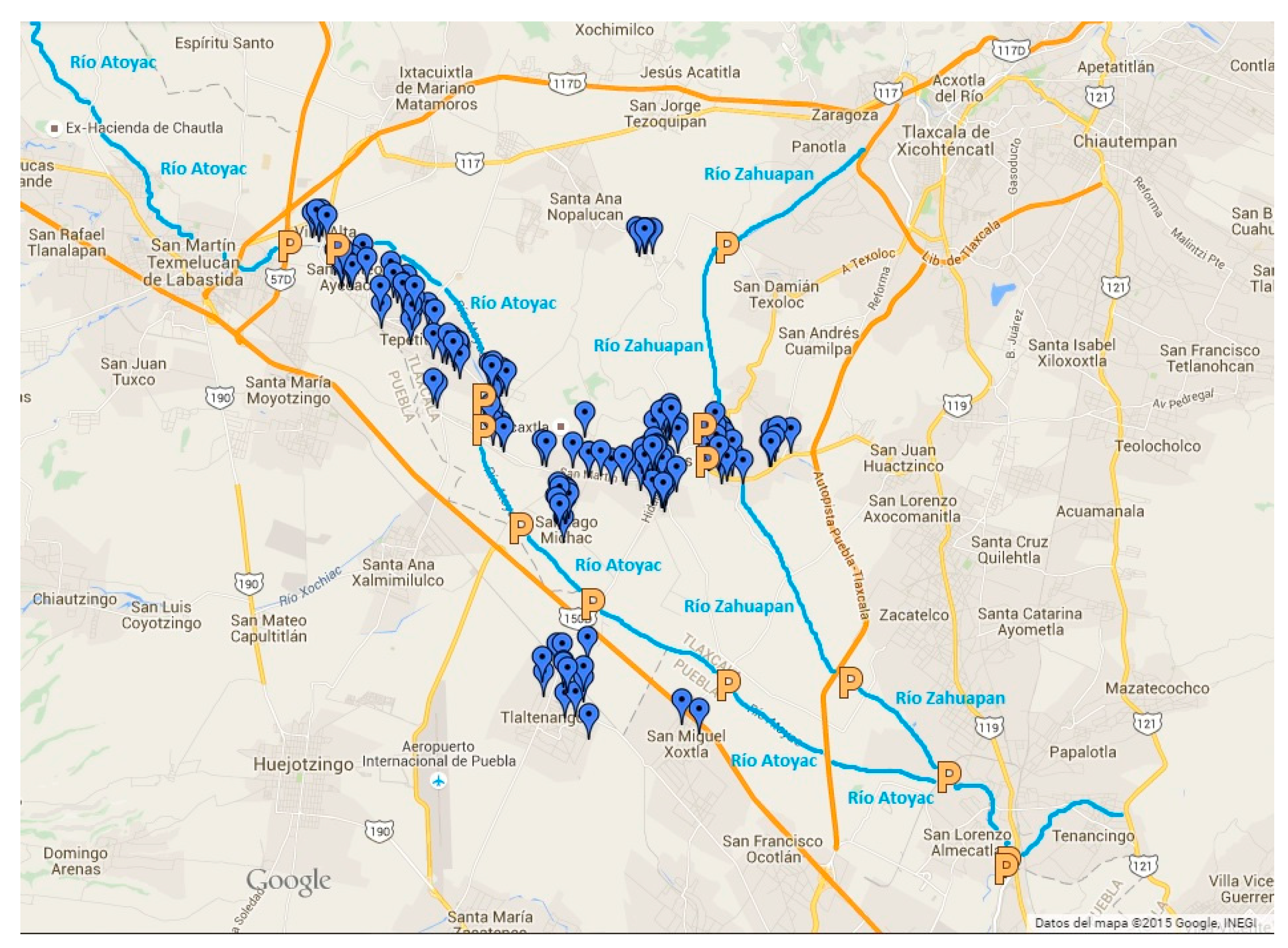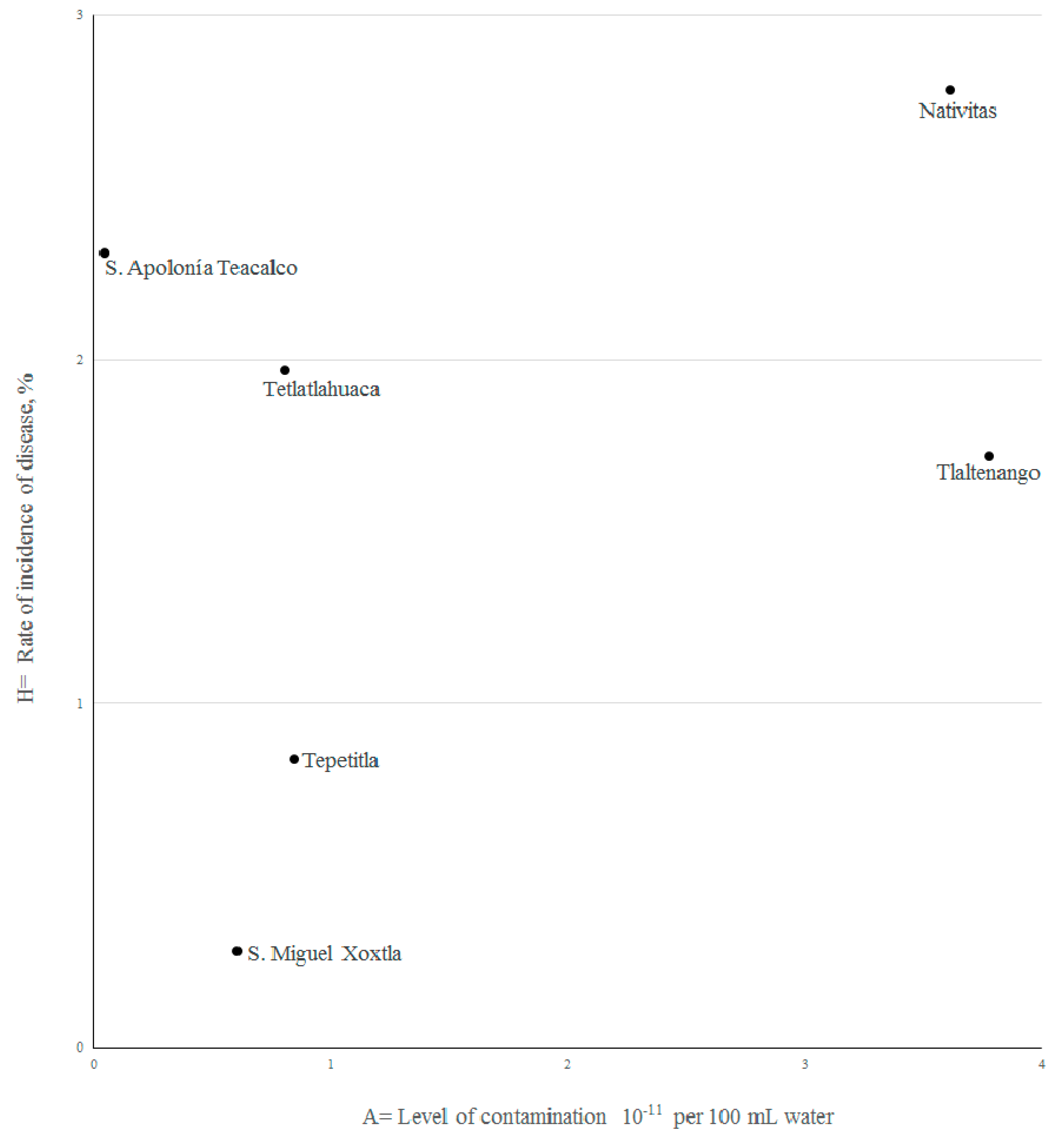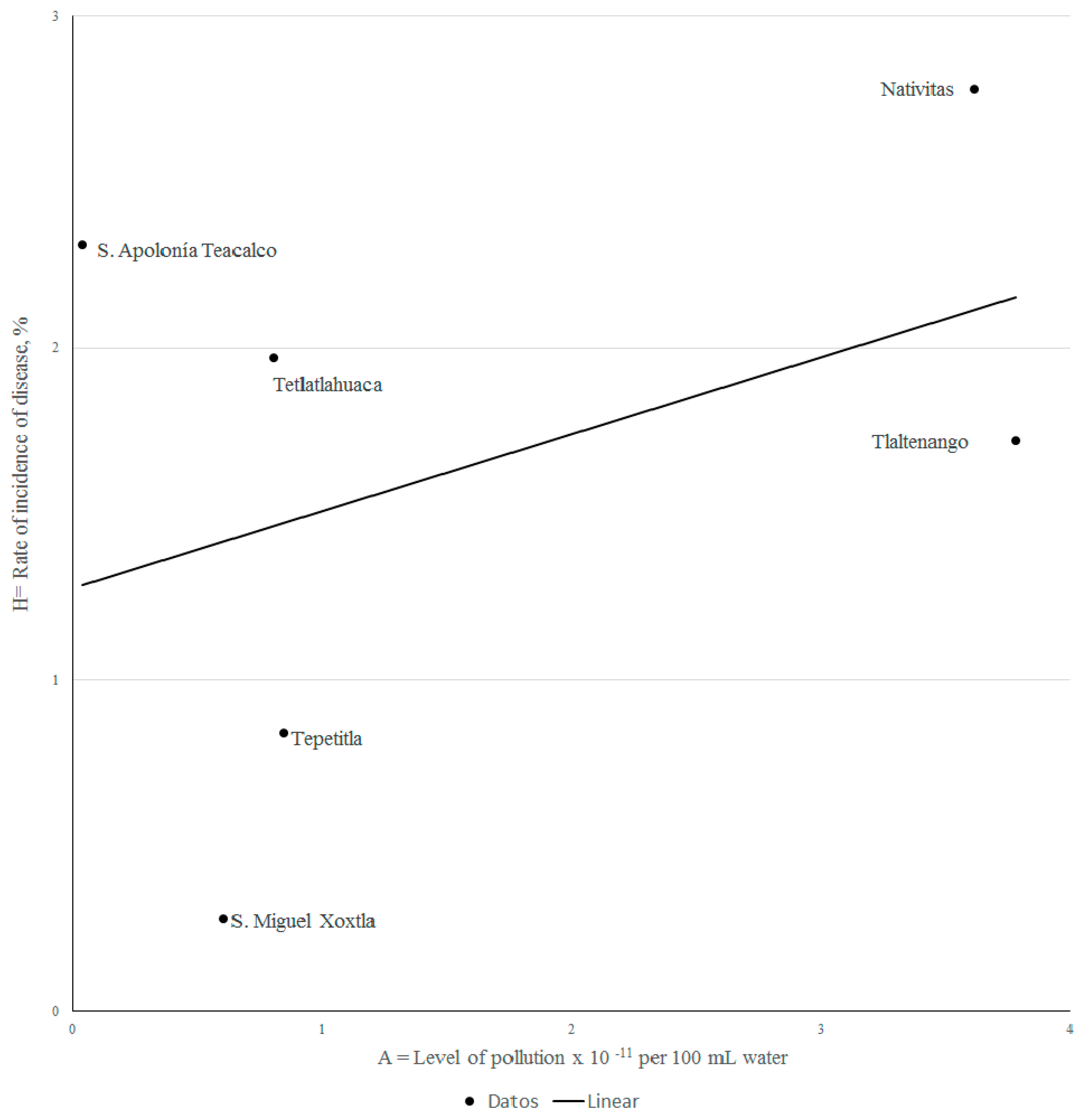Bacterial Pollution in River Waters and Gastrointestinal Diseases
Abstract
:1. Introduction
2. Materials and Methods
2.1. Study Site
2.2. Exploratory Model
2.3 Frequency of Gastrointestinal (GI) Diseases in the Study Region
3. Results
3.1. Simple Lineal Regression Model
3.1.1. Dispersion of Data, Correlation Coefficient and Linear Regression
3.1.2. Linear Regression
3.2. Multiple Regression Analysis
Multiple Regression Calculation
4. Discussion
5. Conclusions
Acknowledgments
Author Contributions
Conflicts of Interest
References
- Sikder, M.T.; Kihara, Y.; Yasuda, M.; Yustiawati; Mihara, Y.; Tanaka, S.; Odgerel, D.; Mijiddorj, B.; Syawal, S.M.; Hosokawa, T.; et al. River Water Pollution in Developed and Developing Countries: Judge and Assessment of Physicochemical Characteristics and Selected Dissolved Metal Concentration. Clean Soil Air Water 2013, 41, 60–68. [Google Scholar] [CrossRef]
- Singh, K.P.; Malik, A.; Sinha, S. Water quality assessment and apportionment of pollution sources of Gomti river (India) using multivariate statistical techniques—A case study. Anal. Chim. Acta 2005, 538, 355–374. [Google Scholar] [CrossRef]
- Nnane, D.E.; Ebdon, J.E.; Taylor, H.D. Integrated analysis of water quality parameters for cost-effective faecal pollution management in river catchments. Water Res. 2011, 45, 2235–2246. [Google Scholar] [CrossRef] [PubMed]
- Gupta, A.; Rai, D.K.; Pande, R.S.; Sharma, B. Analysis of some heavy metals in the riverine water, sediments and fish from river Ganges at Allahabad. Environ. Monit. Assess. 2009, 157, 449–458. [Google Scholar] [CrossRef] [PubMed]
- Törnqvist, R.; Jarsjö, J.; Karimov, B. Health risks from large-scale water pollution: Trends in Central Asia. Environ. Int. 2011, 37, 435–442. [Google Scholar] [CrossRef] [PubMed]
- Agrawal, A.; Pandey, R.; Sharma, B. Water Pollution with Special Reference to Pesticide Contamination in India. J. Water Resour. Prot. 2010, 2, 432–448. [Google Scholar] [CrossRef]
- Donovan, E.; Unice, K.; Roberts, J.D.; Harris, M.; Finley, B. Risk of Gastrointestinal Disease Associated with Exposure to Pathogens in the Water of the Lower Passaic River. Appl. Environ. Microbiol. 2008, 74, 994–1003. [Google Scholar] [CrossRef] [PubMed]
- González, I.N.; Valverde, E.F.; Valladares, R. Evaluación ambiental y epidemiológica para identificar factores de riesgo a la salud por contaminación del Río Atoyac, México. In Proceedings of the XXIX Congreso Interamericano de Ingeniería Sanitaria y Ambiental AIDIS, San Juan, Pureto Rico, 22–27 August 2004. [Google Scholar]
- SEMARNAT. Standard that Establishes the Maximum Permissible Limits of Contaminants in the Discharges of Waste Waters in Waters and National Goods. In Secretaría De Medio Ambiente y Recursos Naturales (SEMARNAT); NOM-001-SEMARNAT-1996; Mexico, 1996; Available online: http://dof.gob.mx/nota_detalle.php?codigo=4863829&fecha=06/01/1997 (accessed on 3 May 2017).
- García, N.E. Plomo y Arsénico en la Subcuenca del Alto Atoyac en Tlaxcala, México. Rev. Chapingo Ser. Cienc. For. Ambiente 2011, XVII, 7–17. [Google Scholar]
- Susser, M. The logic in ecological: I. The logic of analysis. Am. J. Public Health 1994, 84, 825–829. [Google Scholar] [CrossRef] [PubMed]
- Dixon, J.A.; Carpenter, R.A.; Fallon, L.A.; Sherman, P.B.; Manipomoke, S. Economic measurement of impacts on the environment-theoretical basis and practical applications. In Economic Analysis of the Environmental Impacts of Development Projects, 1st ed.; Earthscan: London, UK; 2009; Volume 1, Chapter 3; pp. 19–34. [Google Scholar]
- Borja-Aburto, V.H. Estudios Ecológicos. Salud Pública de México 2000, 42. [Google Scholar] [CrossRef]
- Sánchez, J.S.; Nava, H.M.; Checa, S.C.; Coca, M.F.C.; Vargas, M.C.C. Escenarios de la Cuenca del Río Zahuapan, Tlaxcala, México: Disponibilidad y Contaminación de Agua. Universidad Autónoma de Tlaxcala/INE: México, 2008. Available online: http://www.inecc.gob.mx/descargas/cuencas/2011_cnch2_mon_jsuarez.pdf (accessed on 3 May 2017).
- Comisión Estatal de Agua de Tlaxcala (CEAT). Resultados de Monitoreos Mensuales de los Análisis de Calidad del Agua; Oficial Report; Comisión Estatal de Agua de Tlaxcala: Tlaxcala, México, 2013. [Google Scholar]
- Aquino-Moreno, E. Valoración Económica de los Impactos Ambientales en la Salud por la Contaminación del Río Atoyac. Master’s Thesis, Universidad Autónoma Metropolitana, México City, Mexico, 2015. [Google Scholar]
- Nigenda, G.; Cifuentes, E.; Duperval, P.A. Estimación del Valor Económico de Reducciones en el Riesgo de Morbilidad y Mortalidad por Exposiciones Ambientales; Dirección General de Investigación de Política y Economía Ambiental, Instituto Nacional de Ecologia (INE): Panama City, México, 2002. [Google Scholar]





| Municipality | Total Coliform Bacteria, (MPN/100 mL × 10−10) |
|---|---|
| Natívitas | 36.1 |
| San Miguel Xoxtla | 6.06 |
| SantaApolonia Teacalco | 0.428 |
| Tepetitla | 8.46 |
| Tetlatlahuca | 8.08 |
| Tlaltenango | 37.8 |
| Municipality | Outpatients | Inpatients | Total |
|---|---|---|---|
| Natívitas | 65 | 14 | 79 |
| San Miguel Xoxtla | 2 | 1 | 3 |
| Santa Apolonia Teacalco | 8 | 3 | 11 |
| Tepetitla | 26 | 15 | 41 |
| Tetlatlahuca | 19 | 8 | 27 |
| Tlaltenango | 3 | 5 | 8 |
| Total cases | 123 | 46 | 169 |
| Municipality | Total Cases | Potential Cases | Rate of Incidence |
|---|---|---|---|
| (%) | |||
| Natívitas | 79 | 2,841.42 | 2.78 |
| San Miguel Xoxtla | 3 | 1072.51 | 0.28 |
| Santa Apolonia Teacalco | 11 | 475.33 | 2.31 |
| Tepetitla | 41 | 4904.27 | 0.84 |
| Tetlatlahuca | 27 | 1386.37 | 1.95 |
| Tlaltenango | 8 | 463.99 | 1.72 |
| Total region | 169 | 11,143.89 | 1.52 |
| Month | Level of Pollution |
|---|---|
| (MPN/100 mL) × 10−10 | |
| January | 0.021 |
| February | 0.450 |
| March | 0.430 |
| April | 1.2 |
| May | 2.1 |
| June | 0.94 |
| July | 0.0002 |
| August | 0.0002 |
| September | 220 |
| October | 10.3 |
| November | 1.8 |
| December | 0.067 |
© 2017 by the authors. Licensee MDPI, Basel, Switzerland. This article is an open access article distributed under the terms and conditions of the Creative Commons Attribution (CC BY) license (http://creativecommons.org/licenses/by/4.0/).
Share and Cite
Rodríguez-Tapia, L.; Morales-Novelo, J.A. Bacterial Pollution in River Waters and Gastrointestinal Diseases. Int. J. Environ. Res. Public Health 2017, 14, 479. https://doi.org/10.3390/ijerph14050479
Rodríguez-Tapia L, Morales-Novelo JA. Bacterial Pollution in River Waters and Gastrointestinal Diseases. International Journal of Environmental Research and Public Health. 2017; 14(5):479. https://doi.org/10.3390/ijerph14050479
Chicago/Turabian StyleRodríguez-Tapia, Lilia, and Jorge A. Morales-Novelo. 2017. "Bacterial Pollution in River Waters and Gastrointestinal Diseases" International Journal of Environmental Research and Public Health 14, no. 5: 479. https://doi.org/10.3390/ijerph14050479
APA StyleRodríguez-Tapia, L., & Morales-Novelo, J. A. (2017). Bacterial Pollution in River Waters and Gastrointestinal Diseases. International Journal of Environmental Research and Public Health, 14(5), 479. https://doi.org/10.3390/ijerph14050479





